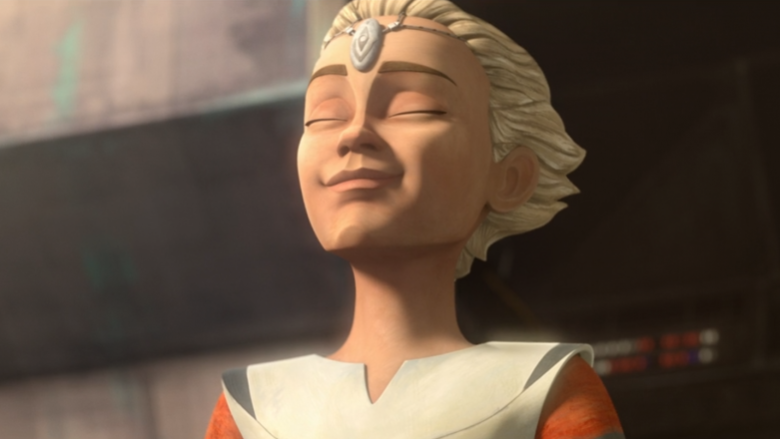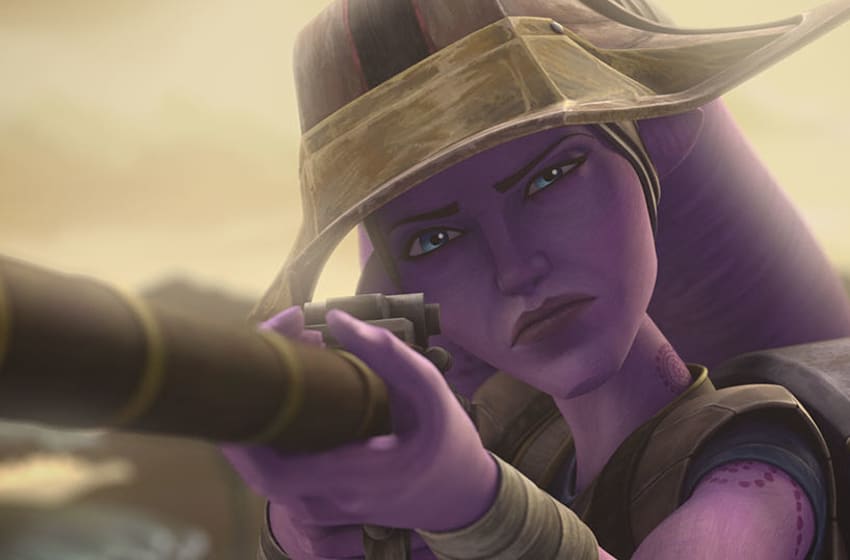The Bad Batch assumed its standard Friday air date with episode two, “Cut and Run,” which turned out to be a play on words with the return of Cut and Suu.
The Plot

Viewers are in for a real treat to see this pair again since their appearance in The Clone Wars. Cut was a deserter whom Rex didn’t turn in because Cut proved his own valor and courage in service to his found family instead of the Republic.
It’s clear that the Bad Batch have met Cut and Suu before and are friends. Perhaps this story might be told in a novel, but for now, the viewer has to accept that they trust each other deeply even if the “why” is not explained (and to be honest, it doesn’t really need to be). Ultimately, Cut is the thematically appropriate choice for the Bad Batch to regroup with, and that’s more important to the story.
Under increased surveillance by the new Empire, Cut and Suu need the Bad Batch’s help to forge chain codes so they can escape with their kids to a deserted planet. Hunter decides that Omega needs to go with them for her own safety. Omega, to nobody’s surprise, disagrees.
The Good

This episode centers a lot of first experiences.
The Bad Batch have broken rules before, and they weren’t always the most popular unit in the regiment, but it’s the first time they’ve been wanted by the same army they once used to serve.
Omega experiences dirt for the first time, a stark contrast to the water planet Kamino and the sterile interiors of her home there. Seeing her delight in the dirt and grime was lovely, especially since Star Wars tends to focus on lonely kids from their desert planets. It’s a shame we didn’t get to see Anakin experience the wonder of abundant water on Naboo or Coruscant, or even Luke leaving the planet of Tatooine to find himself immersed in the humid jungle on Yavin. Force Awakens and Last Jedi at least show Rey marveling at the green Takodana and the rain that falls as she waits for Luke. Seeing the flip side of this, and seeing a character take so much joy in something different and unknown to them, struck a delightful and emotive grace note that really served to underscore the main thematic elements of family and choice.
In the same way that dirt is unknown to Omega, so is the idea of family to the Bad Batch, with these emotions focusing specifically on Hunter. Cut’s return to the narrative thematically answers the central question of why a band of soldiers, whose own childhoods were stolen from them, would bother keeping a child around.
Sending Omega away is a hard choice for Hunter, but he thinks it’s the right one because he knows what a child needs. It’s easy to infer why he might feel this way. Clones had no parents, and their own childhood was Omega’s: to serve a purpose (even if Omega’s is unknown). Their purpose did not include playing ball with other kids–it involved preparing for war, learning how to kill.
During the course of the episode, Omega leaves the safety of the fence to retrieve a wayward ball, which puts her in danger from a wild beast. The emotions surrounding this encounter anchor this theme of family and need. It would have been easy for the writers to use the moment to show us what makes Omega special, but it doesn’t go for that flashy route.
It is no surprise that Hunter feels unsuited for the job of taking care of Omega because he knows there’s more to it than physical protection. He was able to take care of the wild beast that threatened her just fine, but he did not know how to comfort her. That fell to Cut.
Omega is allowed to be scared, allowed to be ashamed, just like Hunter is allowed to be scared for her. Omega hides in the safety of Cut’s arms, burrowing her face in his shoulder, as he picks her up and brings her back to the house. Later, she cries in the shuttle as she removes her Kaminoan hair piece. It’s hard to leave home, and Omega is allowed to grieve the loss.
In the same way, the Bad Batch come to terms that they are deserters now. The sense of loss is tangible in these moments.
Highlighting emotional vulnerability over action sequences was such a strong choice for the episode. It also burns towards the penultimate decision in the episode: Hunter thinks that Omega would be better off with Cut and Suu, but Omega wants to be with the Bad Batch.
The choices of each are respected, and their mistakes are met with kindness. Though Hunter made the mistake of not telling Omega his intentions, he accepts the choice Omega makes to stay with them. Omega, even though Hunter erred, understands why he made the decision he did.
Both Omega and Hunter are allowed to make mistakes without shame. Even though Omega expresses fear she did something wrong several times, it’s never proven correct by the adults surrounding her (which does make one wonder how she was treated on Kamino). In the same way, Suu assures Hunter that children will get into trouble–they won’t be soldiers who follow orders–and that’s shown as a good thing.
Though Crosshair did not appear and was only mentioned once by name, I’m excited for the emotional foreshadowing to be fulfilled. With so much emphasis around choice, family, and defection, I expect nothing but the greatest angst when Crosshair collides with the Bad Batch, and he too will need to choose.
The Bad

Narratively speaking, the only thing I really missed is what Echo’s feeling. They find out they missed Rex by a day and we get almost nothing from Echo, except an exclamation, who surely must be feeling this loss, this forced desertion, in a fundamentally different way than the rest of the Bad Batch. I understand the decision to make Hunter the “main” clone of the ensemble cast, but I’m craving for something from Echo that isn’t just narrative functionality.
I will be mentioning the whitewashing with each episode because it’s not a commentary that should be reserved for just the premiere. As long as these designs remain the same, it disrespects the many and diverse fans of the Star Wars community.
The strength of the second episode makes the decision to whitewash even more frustrating, because this series could be great, and this decision makes it not great.
In Conclusion
This was an emotional follow-up to an action packed premiere that had a lot of great moments. Tune in next week!